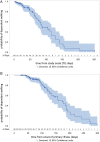First results about recovery of walking function in patients with intensive care unit-acquired muscle weakness from the General Weakness Syndrome Therapy (GymNAST) cohort study
- PMID: 26700274
- PMCID: PMC4691758
- DOI: 10.1136/bmjopen-2015-008828
First results about recovery of walking function in patients with intensive care unit-acquired muscle weakness from the General Weakness Syndrome Therapy (GymNAST) cohort study
Abstract
Objectives: To describe the time course of recovery of walking function and other activities of daily living in patients with intensive care unit (ICU)-acquired muscle weakness.
Design: This is a cohort study.
Participants: We included critically ill patients with ICU-acquired muscle weakness.
Setting: Post-acute ICU and rehabilitation units in Germany.
Measures: We measured walking function, muscle strength, activities in daily living, motor and cognitive function.
Results: We recruited 150 patients (30% female) who fulfilled our inclusion and exclusion criteria. The primary outcome recovery of walking function was achieved after a median of 28.5 days (IQR=45) after rehabilitation onset and after a median of 81.5 days (IQR=64) after onset of illness. Our final multivariate model for recovery of walking function included two clinical variables from baseline: the Functional Status Score ICU (adjusted HR=1.07 (95% CI 1.03 to 1.12) and the ability to reach forward in cm (adjusted HR=1.02 (95% CI 1.00 to 1.04). All secondary outcomes but not pain improved significantly in the first 8 weeks after study onset.
Conclusions: We found good recovery of walking function for most patients and described the recovery of walking function of people with ICU-acquired muscle weakness.
Trials registrations number: Sächsische Landesärztekammer EK-BR-32/13-1; DRKS00007181, German Register of Clinical Trials.
Keywords: REHABILITATION MEDICINE.
Published by the BMJ Publishing Group Limited. For permission to use (where not already granted under a licence) please go to http://www.bmj.com/company/products-services/rights-and-licensing/
Figures
Similar articles
-
The General Weakness Syndrome Therapy (GymNAST) study: protocol for a cohort study on recovery on walking function.BMJ Open. 2014 Oct 24;4(10):e006168. doi: 10.1136/bmjopen-2014-006168. BMJ Open. 2014. PMID: 25344484 Free PMC article.
-
Health-related quality of life, participation, and physical and cognitive function of patients with intensive care unit-acquired muscle weakness 1 year after rehabilitation in Germany: the GymNAST cohort study.BMJ Open. 2018 Jul 13;8(7):e020163. doi: 10.1136/bmjopen-2017-020163. BMJ Open. 2018. PMID: 30007926 Free PMC article.
-
Fitness and mobility training in patients with Intensive Care Unit-acquired muscle weakness (FITonICU): study protocol for a randomised controlled trial.Trials. 2016 Nov 24;17(1):559. doi: 10.1186/s13063-016-1687-4. Trials. 2016. PMID: 27881152 Free PMC article. Clinical Trial.
-
[Intensive Care Unit-Acquired Weakness].Hu Li Za Zhi. 2020 Jun;67(3):6-13. doi: 10.6224/JN.202006_67(3).02. Hu Li Za Zhi. 2020. PMID: 32495324 Review. Chinese.
-
Corticosteroid use and intensive care unit-acquired weakness: a systematic review and meta-analysis.Crit Care. 2018 Aug 3;22(1):187. doi: 10.1186/s13054-018-2111-0. Crit Care. 2018. PMID: 30075789 Free PMC article.
Cited by
-
Impact of Early Rehabilitation Initiation on Walking Recovery in Critically Ill Patients.Cureus. 2025 Jul 19;17(7):e88280. doi: 10.7759/cureus.88280. eCollection 2025 Jul. Cureus. 2025. PMID: 40831867 Free PMC article.
-
A multimodal rehabilitation program for patients with ICU acquired weakness improves ventilator weaning and discharge home.J Crit Care. 2018 Oct;47:204-210. doi: 10.1016/j.jcrc.2018.07.006. Epub 2018 Jul 11. J Crit Care. 2018. PMID: 30025227 Free PMC article.
-
Longtime Neurologic Outcome of Extracorporeal Membrane Oxygenation and Non Extracorporeal Membrane Oxygenation Acute Respiratory Distress Syndrome Survivors.J Clin Med. 2019 Jul 12;8(7):1020. doi: 10.3390/jcm8071020. J Clin Med. 2019. PMID: 31336827 Free PMC article.
-
The association of macronutrient deficit with functional status at discharge from the intensive care unit: a retrospective study from a single-center critical illness registry.Eur J Clin Nutr. 2022 Apr;76(4):551-556. doi: 10.1038/s41430-021-01001-5. Epub 2021 Aug 30. Eur J Clin Nutr. 2022. PMID: 34462556
-
Brazilian version of the Functional Status Score for the ICU: translation and cross-cultural adaptation.Rev Bras Ter Intensiva. 2017 Jan-Mar;29(1):34-38. doi: 10.5935/0103-507X.20170006. Rev Bras Ter Intensiva. 2017. PMID: 28444070 Free PMC article.
References
Publication types
MeSH terms
Associated data
LinkOut - more resources
Full Text Sources
Other Literature Sources
Medical
Research Materials


